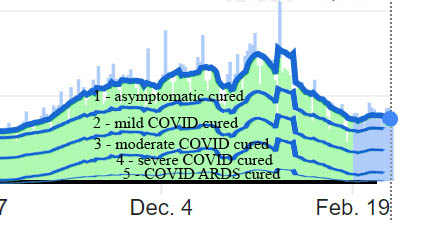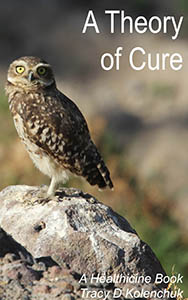According to the statistical 7 day average for last week – ending March 12th, almost 370,000 new cases of COVID were diagnosed and about 8500 people died every day. How many people were cured?
There are no statistics of CURED for COVID-19. Why not? Actually, it’s not hard to create them. First, lets look at New cases.
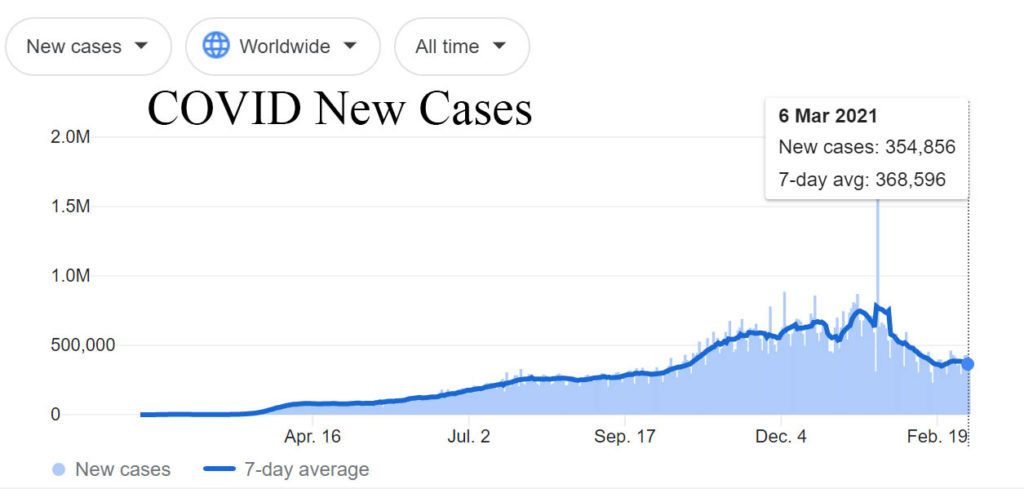
The online graph of new cases is updated adding day, using data from the previous week. The above image shows the graph as of March 13, 2021. It’s a familiar image.
We can change the view, to show COVID-19 deaths, by simply clicking the New cases arrow and selecting Deaths.
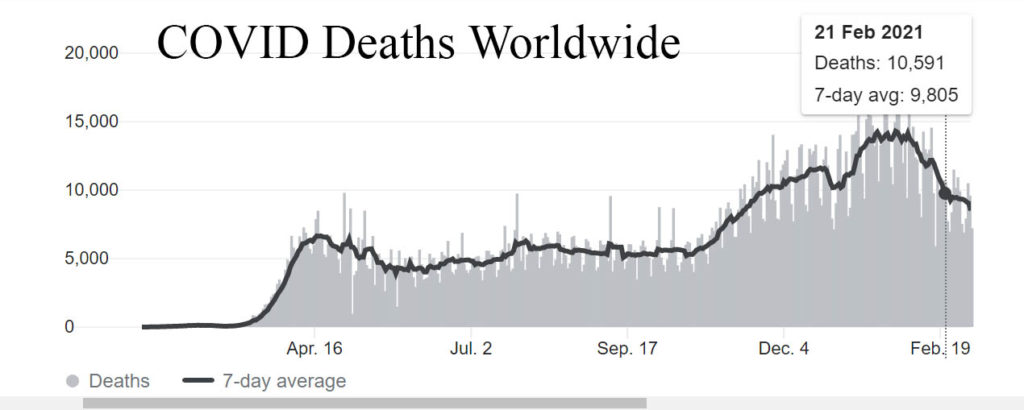
The page also shows statistics for total cases RECOVERED, 67,000,000 but there is no graph for RECOVERED.
But, there are no statistics and no graph of CURED. Can we create one?
Where to start? First we need to normalize the two graphs. The scales used to display the graph for CASES and the graph for DEATHS is dramatically different, potentially giving a strange impression. This next image maps both into a single graph with DEATHS normalized to the same scale as CASES.
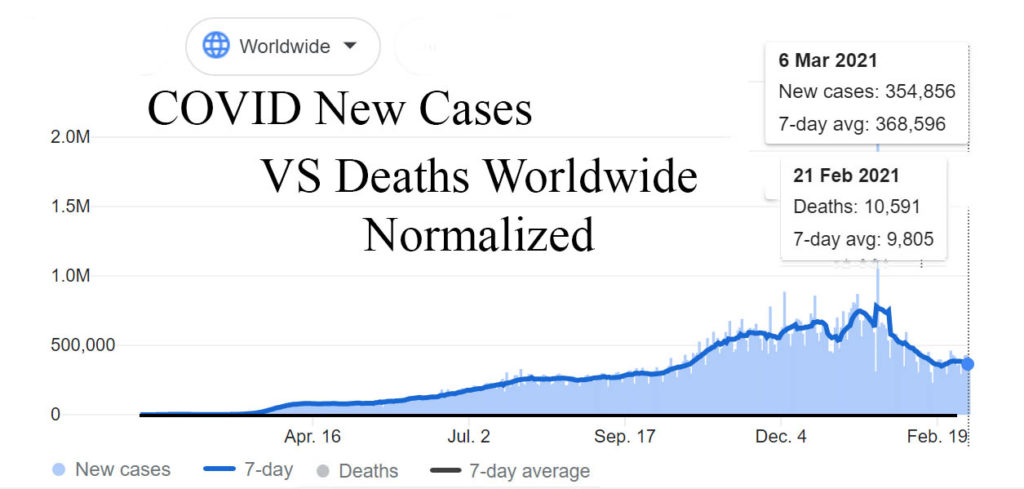
That thin black line at the bottom, is the number of deaths, scaled to match the number of cases. It is a thin unchanging line because the number of deaths is too low in comparison to cases, to show any changes. The line is actually to thick to be accurate – but it gives a useful view.
Now, we need a definition of CURED for COVID-19. Have you seen a definition of COVD-19 cured? There doesn’t seem to be one anywhere.
Is COVID-19 like the common cold, as in “There is no cure for the common cold“? I’ve had lots of colds. All cured. When I’m healthier, I get fewer colds and cure them faster, when I’m not so healthy, I get colds more often, and they last longer. Obviously, people are cured of the common cold – even though there is no medical cure. And COVID?
We can find a medical definition of cured for COVID. We just need to know where to look. ClinicalTrials.GOV lists over 370,000 clinical trials for COVID, about one for every ten people who have died from the disease. However, when we limit our search to trials containing the word CURED, there are only 19 . We can study these trials to find a scientific medical definition of COVID-19 cured? Yes. But, although we will find several different definitions, for good reasons. COVID-19, like cancer, is not well defined. It is defined for diagnosis and treatment purposes, not for curative purposes.
STUDY: Effectiveness of Ivermectin as add-on Therapy in COVID-19 Management defines cured according to a treatment, “Primary outcome {cured} is assessed by calculating the number of patients who had symptoms free(*1) and two successive readings of negative PCR swab.” The patients studied were “with age above 18 years and any gender with definite Dx of covid19 and pneumonia.” and “Excluded: Patient with covid 19 positive and mild no pneumonia“. Normal COVID-19 patients are not studied. It appears, but is not reported directly, that all 16 patients were cured, in an average of 7 days.
Patients diagnosed with COVID-19 were judged cured only if:
1. They were also diagnosed with pneumonia and
2. the treatment was administered and
3. they were shown to be symptom free and
4. able to pass a PCR test.
However, we can see that each of these patients actually had TWO diseases. The World Health Organization has a disease code for COVID-19 (U07.1 COVID-19) infection, and another for COVID-19 Pneumonia (J12.82 Pneumonia due to coronavirus disease 2019)(*2). Note: There is no code for the SARS-CoV-2 infection, only a code for exposure to SARS-CoV-2 (Z20.822 Contact with and (suspected) exposure to COVID-19). Can a person be cured of “contact with and suspected exposure to ..”? Each patient was cured once – 16 cures; but two (or was it three?) diseases were cured – 32 or more possible disease cures. It gets more complicated. It is possible that the SARS-CoV-2 infection was cured before the pneumonia was diagnosed. Also, pneumonia can be caused by many different bacterial or viral infections in addition to the SARS-CoV-2 infection. No wonder cured is not defined.
If we defined CURED by disease, it’s very confusing and probably not worthwhile in the bit picture. It makes more sense, in these cases, to define cured by patient.
Treatment of Acute Severe 2019-nCoV Pneumonia With Immunoglobulin From Cured Patients presents a different view. It studies a potential medicine extracted from cured patients. How are cured patients defined? Unfortunately, the study does not present a definition of cured other than “immunoglobulin in 2019-ncov pneumonia cured patients.” It is clear that normal COVID-19 patients are excluded, because normal cases of COVID-19 do not get 2019-ncov pneumonia. How were the study cured patients cured? Not specified. How were they tested as being cured? Not specified. Perhaps the assumption is that “cured” is obvious – and a scientific definition is not required. Note: This study is in Wuhan, China. It was defined in April 2020, and the Estimated Completion Date was May 31, 2020. As of March 2021, according to ClinicialTrials.GOV, recruiting has not yet started and no results have been posted for this study. Sometimes, science is crap, or perhaps just our tracking of science is crap?
However, we can use the study design to define CURED as – no longer infected. The restriction of 2019-ncov pneumonia is an added constraint for the study, but not required for a definition of COVID-19 cured. Most COVID-19 patients do not get COVID-19 pneumonia.
STUDY: Study for Quantitative Analysis of the Recovered COVID-19 Patients by 18F-FDG-PET/CT studied three groups of subjects (not just patients). Two of which are considered cured:
1, “clinically cured patients with severe COVID-19;
2. clinically cured patients with mild COVID-19; and
3. healthy people who are not infected with COVID-19.”
Clinically cured is not defined explicitly, but is stated for both groups as “Patients with COVID-19 cured were determined based on nucleic acid tests, CT examinations, and clinical criteria. The age of patient were between 18 and 85 years, meanwhile in Zhuhai they were confirmed as COVID-19, cured and all received by COVID-19 drug therapy.” Like much of conventional medicine, cures don’t count unless the patient is treated with a drug. Note; Cured is defined at the beginning of the study, and goals are to study consequences of the illness, not of the cure. No results have been posted.
STUDY: Efficacy and Safety of Anti HCV Drugs in the Treatment of COVID-19 measures cured as “Virological cure using the triple therapy as compared to mono hydroxychloroquine treatment.” Again, cured is not defined except in patients who are treated with a medicine, but once treated, cured can be documented. No results are posted. This study was prepared in Cairo and appears to have been stopped due to the anti-hydroxychloroquine movement.
Cured is not defined explicitly, but appears to be defined as tested by a negative PCR test, as a “positive reverse-transcriptase-polymerase chain- reaction (RT-PCR) assay for SARS- CoV-2 in a respiratory tract sample” is an eligibility requirement. Patients who are no longer infected by SARS-CoV-2 are cured.
STUDY: Post-intensive Care Follow-up of Patients Hospitalized for an Acute Respiratory Distress Syndrome Caused by COVID-19 (RE-CoV-ERY) is a study of post COVID, post ARDS, patients who might also suffer from PTSD. The word cure is used with reference to preventing PTSD, not to curing COVID, “to screen the complications after intensive-care with, find solutions to cure them or decrease their impact on patient’s life to improve quality of life and prevent the post-traumatic syndrome disorder PTSD.”(*3) There is no discussion of the cured, or not cured status of patients in this study, they are simply referred to as post-intensive care patients. Cured and not cured PTSD status are both ignored.
In summary:
There are different types of cured related to COVID-19.
First: are natural cures of the Sars-CoV-2 infection. These are generally considered unimportant and excluded from clinical studies, because they were not treated with drugs. They were not clinically cured. These cures are not counted.
Second: Patients who are cured of the infection with a medical or non-medical treatment are generally ignored unless they were hospitalized. Patient’s whose doctors recommend hydroxychloroquine, Vitamin D, zinc, or any other treatment might be cured, or die. Deaths are counted. These cures are not counted.
Third: Patients who acquire ARDS (Acute Respiratory Distress Syndrome), were hospitalized and treated with a drug that gets credit for the cure. These patients can be considered clinically cured, and are eligible for studies of clinically cured patients. However, these are not tracked statistically. In these cases, cured patients are cured of two diseases, the SARS-CoV-2 infection and of COVID-19 ARDS.(*4) However, there are no statistics for these cures.
Fourth: Patients who advance to COVID-pneumonia require three cures, one for the Sars-CoV-2 viral infection, one for ARDS, and another for the COVID-pneumonia. However, these are typically treated as a single cure “of the patient.” They can also be classed as clinically cured, but only if they were treated with a drug in a clinical study. These cures are not counted, and there are no statistics for individual diseases cured, nor for patients cured.
Fifth: Patients who suffer severe consequences of treatment for COVID-19 ARDS, and suffer COVID-PTSD. Cured is not defined for PTSD. These patients might be cured of COVID-19 PTSD at a later date, but because cured is not defined, these cures cannot be recognized, much less counted.
Clinical cures occur in clinical studies after treatment with a drug, and can be documented as cured. They are not counted as part of our COVID-19 tracking. Natural cures are simply ignored. When is no medical treatment, no studies are undertaken for these patients. Because no medicine is required, there is no medical nor scientific interest in any “cause of a cure” for these patients.
Who is cured?
Basically, everyone who doesn’t die is a cured patient. Some might have only been cured of the infection. Some, who developed more severe symptoms, were cured of COVID-19. Survivors who were hospitalized for ARDS were cured of ARDS – although the cure might not be perfect. No cure is perfect. Patients who acquired COVID-19 pneumonia either died, or were cured. Patients with COVID-19 PTSD were cured of the infection, cured of ARDS, possibly cured of COVID-19 pneumonia. Some might also be cured of PTSD, but there is no definition of PTSD cured, much less a test, so these cures cannot be recognized.
We can count cures by patients: a patient who has been cured of any COVID-19 diseases (Sars-CoV-2 infection, ARDS, COVID-pneumonia, COVID-PTSD) has been cured. Or we can count by disease. Patients who are cured of the infection, the ARDS, and COVID-pneumonia might be viewed has having three cures. Some, those who suffer ARDS, or acquire disabilities like PTSD, might not be completely cured, but if they are not dead, the infection has been cured, and the ARDS has at least been partially cured.
So…. Back to the chart. Where are the cured? If everyone who is not dead is eventually cured, the graph changes when we add CURED in green. Like deaths, cured lags behind New Cases.
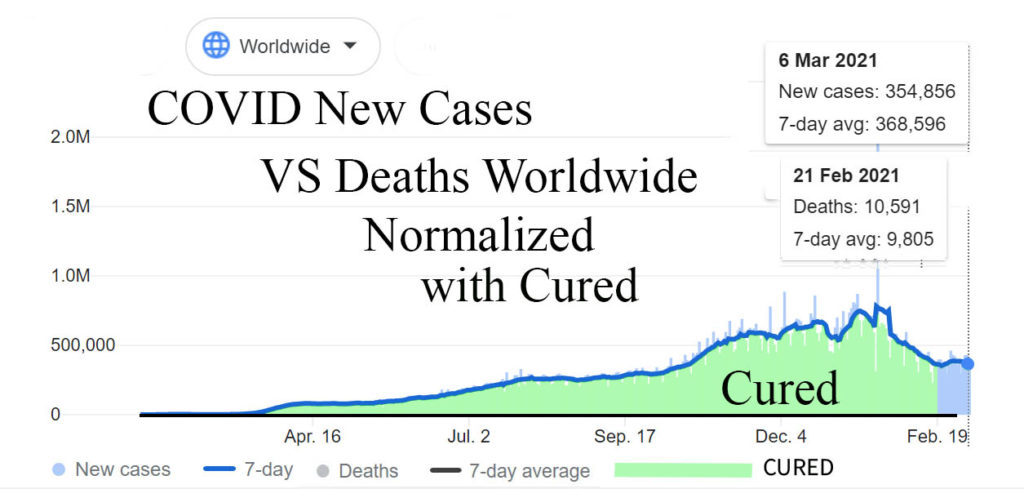
Most cases of COVID-19 are cured. Most are cured naturally, not hospitals, because most COVID-19 patients are not hospitalized. Very few patients are cured in clinical studies, because clinical studies only study small numbers of patients at a time, and in general, only study severe cases. Most cases of COVID-19 are not severe.
RECOVERED?
Maybe you’ve noticed, if you view the worldwide COVID statistics, the statistic for RECOVERED. Is RECOVERED the same as CURED? No. Although RECOVERED patients are cured, but not all cured patients are listed as RECOVERED. Many countries, including the USA, the United Kingdom, and Spain do not report recovered. Why not? I suspect it’s because, in addition to the fact that reporting of deaths by COVID-19 can be inconsistent from area to are, hospital to hospital, country to country, reporting of RECOVERED is known to be even less consistent. Patients who are recovered, like patients who are cured, are simply ignored.
When we look at the big picture, the RECOVERED numbers don’t make sense. There is, probably for good reasons, no graph for RECOVERED. This graph shows the hypothetical addition of RECOVERED, as currently reported.

The Best Cures:
Where are all the COVID-19 Cured patients? They’re everywhere, but our medical systems, our bureaucrats, and our media are blind to them.
- If we want to find the best cures for asymptomatic cases, we need to study the people who are cured, and determine why they were cured without a medicine.
- If we want to find the best cures for patients who suffer mild cases of COVID-19, we need to study those who are cured, to determine why they were cured without a medicine.
- To find the best cures for patients with moderate cases of COVID-19, we need to study those who are cured to determine how they were cured.
- If we want to find the best cures for patients who are hospitalized, but don’t advance to ARDS, we need to study the ones who are cured, to determine the causes of their cures.
- To find the best cures for patients who suffer ARDS, we need to study those who are cured, not just the drugs they were treated with, to determine the causes of their cures.
- To find the best cures for patients who suffer COVID-19 pneumonia, we need too study those who are cured and determine the causes of their cures.
- To find the best cures for patients who suffer COVID-19 PTSD, we need to define PTSD cured, so we can study those who are cured and learn the best causes of their cures.
This image shows what our COVID-19 cured statistics might look like, worldwide, if we actually track cured patients. Unfortunately, we don’t track cured patients, so we cannot create this graph. Note: The numbers for COVID-19 pneumonia and COVID-19 PTSD, and possibly even the COVID ARDS cases are probably so low that they are inside the black line at the bottom.
If we want to find cures, we need to study cured patients more than we study drugs that don’t cure.
to your health, tracy
Author; A Theory of Cure
*1 – many clinical study documents in ClinicalTrisls.GOV are from other countries, translated into English, and the translations are often poor English. This study was approved by the IRB of Baghdad Teaching Hospital of The General Directorate of Medical City.
*2 – COVID-19 pneumonia can be pneumonia caused by the SARS-CoV-2 virus, or it can be pneumonia that results from ARDS and a different bacterial or viral cause.
*3 – Note: CURED is not defined for PTSD in this study or in any medical theory.
*4 – COVID-19 ARDS is not listed in the World Health Organization’s list of diseases, although it is recognized by the National Institute of Health in the USA. https://www.ncbi.nlm.nih.gov/pmc/articles/PMC7361309/

